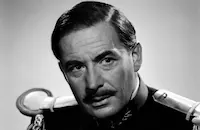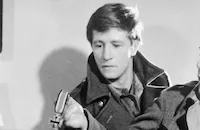55 Days at Peking

Brief Synopsis
Cast & Crew
Nicholas Ray
Charlton Heston
Ava Gardner
David Niven
Flora Robson
John Ireland
Film Details
Technical Specs

Synopsis
In June, 1900, legations in Peking representing 11 countries are threatened by the fanatical Boxers, a band of terrorists determined to drive the "foreign devils" out of China. Encouraged by Dowager Empress Tzü Hsi and her adviser, Prince Tuan, the Boxers move into the city and murder the German ambassador. Although most of the envoys vote to flee Peking, British Ambassador Sir Arthur Robertson persuades them to remain and make a stand. With only 500 military units at their disposal, the legations depend on the leadership of U. S. Marine Maj. Matt Lewis, who has prevented the deportation of Russian Baroness Natalie Ivanoff, widow of an aristocrat who committed suicide over her infidelity. Meanwhile, the empress orders the Imperial Army to aid the Boxers in their attack on the foreign powers. When their situation becomes desperate, Natalie obtains precious food and medicine by selling an emerald necklace, but she is fatally wounded while bringing the supplies into their compound. The situation appears hopeless as the Chinese launch a final assault, but on the morning of August 14th, 55 days after the initial uprising, reinforcements from all 11 nations arrive to turn back the Boxers, dethrone the empress, and topple the Manchu Dynasty.

Director

Nicholas Ray
Cast

Charlton Heston

Ava Gardner

David Niven

Flora Robson

John Ireland

Harry Andrews

Leo Genn
Robert Helpmann
Ichizo Itami

Kurt Kasznar
Philippe Leroy

Paul Lukas
Lynne Sue Moon
Elizabeth Sellars
Massimo Serato
Jacques Sernas
Jerome Thor
Geoffrey Bayldon
Joseph Furst
Walter Gotell

Alfred Lynch
Alfredo Mayo
Martin Miller
Conchita Montés
José Nieto
Eric Pohlmann
Aram Stephan
Robert Urquhart
Ronald Brittain
Félix Dafauce
André Esterhazy
Carlos Casaravilla
Fernando Sancho
Michael Chow
Mitchell Kowal

Mervyn Johns

Nicholas Ray
Crew
Alexandre Of Paris
Manuel Berenguer
Samuel Bronston
Alan Brown
Milton Burrow
Veniero Colasanti
Veniero Colasanti
Veniero Colasanti
Grazia De Rossi
Stanley Detlie
C. O. Erickson
Carl Gibson
Bernard Gordon
Robert Hamer
Richard C. Harris
David Hildyard
Jack Hildyard
Noel Howard
James R., (col.) Johnson
Dong Kingman
Robert Lawrence
Lucie Lichtig
José López Rodero
Andrew Marton
Gordon K. Mccallum
John Moore
John Moore
John Moore
Gloria Mussetta
José María Ochoa
Magdalena Paradell
Bruno Pasqualini
Maude Spector
Dimitri Tiomkin
Dimitri Tiomkin
Mario Van Riel
Michael Waszynski
Paul Francis Webster
Alex Weldon
Philip Yordan

Photo Collections
Videos
Movie Clip




Hosted Intro
Film Details
Technical Specs

Award Nominations
Best Score
Best Song
Articles
55 Days at Peking
The story takes place during the Boxer Rebellion, which shook China at the turn of the twentieth century. Angry about foreign powers, imperialist land grabs, and Christian evangelists posing threats to traditional Chinese culture, the ultraconservative Boxers persuaded the ruling Qing Dynasty to drive out the countries responsible for these influences. In the year 1900 a multitude of Boxers swarmed into Peking, as Beijing was then known by Westerners, and drove the foreigners and Chinese Christians living there into a single small area, aided by an influx of government troops. The besieged diplomats, soldiers, and citizens held off their attackers for fifty-five days, until fighters sent by an alliance of eight nations came to the rescue arriving in the nick of time like cavalries in an old-fashioned western, according to the movie's version of these harrowing events.
55 Days at Peking focuses on three main characters. Heston plays Matt Lewis, the tough-as-nails American major who takes command of a 500-man defense unit inside the diplomatic compound. Niven plays Sir Arthur Robertson, the good-natured British ambassador who votes to stay in Peking when all the other diplomats are eager to pack their things and go. Gardner plays Natalie Ivanoff, a fading Russian baroness with a checkered past her infidelity drove her husband to kill himself and a newfound capacity for sacrifice. The most compelling secondary characters are Dowager Empress Tzu-Hsi (Flora Robson), the reigning monarch whose support is crucial to the Boxers' campaign, and Prince Tuan (Robert Helpmann), a schemer who's more interested in power than in the dynasty's long-term wellbeing. Also on hand are Sgt. Harry (John Ireland), who serves Lewis as a sort of conscience, Dr. Steinfeldt (Paul Lukas), a seasoned physician trying to keep the wounded Westerners alive, and Teresa (Lynne Sue Moon), a Chinese-American child orphaned by the conflict.
The screenplay for 55 Days at Peking came from Bernard Gordon, whose credits included such unhistorical fare as Earth vs. the Flying Saucers (1956) and The Day of the Triffids (1962), and the remarkable Philip Yordan, a victim of the Hollywood blacklist who had penned such minor classics as The Man from Laramie (1955) and The Harder They Fall (1956), and had been the front for blacklisted writer Ben Maddow on Ray's legendary western Johnny Guitar in 1954. Yordan's enthusiasm for the project was less than wholehearted, however. "What interested me in 55 Days at Peking was [the salary of] 400,000 dollars," he remarked, according to Bernard Eisenschitz's biography of Ray. "The Boxer Rebellion, big sets, suspenseful, colorful...it was a commercial manufacture job." Gordon also had serious doubts, especially when he found Ray to be "totally lost and frightened to death about the problems of making a large spectacle film." Ray was a gifted director, with such superb achievements as Rebel Without a Cause (1955) and Bigger Than Life (1956) to his credit, as well as Bronston's recent epic King of Kings. But here he found himself without a proper script the stars often received their dialogue shortly before the camera rolled, or simply made their lines up and his shaky health was deteriorating because of stress, alcohol, and medications. The outlook was as grim for the project as for the besieged characters in their compound.
The wheels of the production were spinning, though, and there was no way to stop them. A sizable chunk of historic Peking was built near Madrid, much of it in concrete, more to impress visiting VIPs than to enhance the set's effectiveness on screen; according to Heston, the crew "never turned a camera on two-thirds of this incredible city." Since the picture was presold to distributors around the world, Bronston's agents tried to hire a roster of international stars for secondary roles Michel Simon and Tom Courtenay were among those announced to the press but Eisenschitz reports that none of them materialized, leaving Ray to do the best he could with third or fourth choices. Gardner and Heston showed up as promised but took an instant dislike to each other, and Gardner spent so much time drinking in her dressing room that Yordan claims a stand-in was used for many over-the-shoulder shots. Ray eventually collapsed under the strain, so Heston's friend Guy Green came in to direct the remaining scenes while second-unit coordinator Andrew Marton proceeded with the battle sequences. Filming was completed in a rush, with two units shooting night and day, since Heston and Niven were well past the leave dates in their contracts. Charles Higham summed up the results in his biography of Gardner, saying the picture "helped to destroy Bronston's career, severely damaged Ava's, and virtually finished Nicholas Ray's."
Despite this avalanche of troubles, 55 Days at Peking drew respectful comments from a number of influential critics. Judith Crist wrote in the New York Herald Tribune that while many scenes are "pretty trite stuff very pretty and very trite...there's a lusty vigor and infectious excitement" in the battle scenes. New York Times critic A.H. Weiler called the film "rousing, sometimes exciting, action fare that should keep the customers alert and entertained even if their intellects are confused" by the "foggy" handling of the characters and their motivations. Variety admired the picture's "uncommon visual excitement" and Jack Hildyard's "excellent" photography, commended Heston and Niven for acting "with conviction," and applauded Robson for making the Dowager Empress "strikingly authentic." Time noted the film's lavish production values the $9 million budget, the 6,500 extras, the high cost of replicating Peking and then blowing it all up and praised the pictorially "magnificent" end product.
Auteur critics have generally failed to detect any of Ray's creative personality in the film, but Geoff Andrew of TimeOut points to "many details which echo moments in his earlier work" and calls the movie "an unusually ambitious and intelligent example of the epic genre." It's hard to deny that 55 Days in Peking is short on psychological depth and historical accuracy, and the dialogue contains the kind of insensitive racial comments that have become mercifully rare today. Still, the visuals are as arresting as ever it's no wonder that reviewer after reviewer has praised the spectacular fireworks, especially at the climax and the movie vividly represents a bygone age of international spectaculars that made up in extravagance what they sometimes lacked in coherence and common sense.
Director: Nicholas Ray
Producer: Samuel Bronston
Screenplay: Philip Yordan and Bernard Gordon; additional dialogue: Robert Hamer
Cinematographer: Jack Hildyard
Film Editing: Robert Lawrence
Set Decoration, Production and Costume Design: Veniero Colasanti and John Moore
Music: Dimitri Tiomkin
With: Charlton Heston (Maj. Matt Lewis), Ava Gardner (Baroness Natalie Ivanoff), David Niven (Sir Arthur Robertson), Flora Robson (Dowager Empress Tzu-Hsi), John Ireland (Sgt. Harry), Harry Andrews (Father de Bearn), Leo Genn (Gen. Jung-Lu), Robert Helpmann (Prince Tuan), Kurt Kasznar (Baron Sergei Ivanoff), Philippe Leroy (Julliard), Paul Lukas (Dr. Steinfeldt), Elizabeth Sellars (Lady Sarah Robertson), Massimo Serato (Garibaldi), Jacques Sernas (Maj. Bobrinski), Jerome Thor (Capt. Andy Marshall), Geoffrey Bayldon (Smythe), Joseph Furst (Capt. Hanselman), Walter Gotell (Capt. Hoffman), Ichizo Itami (Col. Shiba), Mervyn Johns (Clergyman), Alfredo Mayo (Spanish Minister), Martin Miller (Hugo Bergmann), Conchita Montes (Mme Gaumaire), Jose Nieto (Italian Minister), Eric Pohlmann (Baron von Meck), Aram Stephan (Gaumaire), Robert Urquhart (Capt. Hanley), Lynne Sue Moon (Teresa).
C-160m. Letterboxed.
by David Sterritt

55 Days at Peking
Quotes
Trivia
Director Nicholas Ray walked off the set. Andrew Marton and Guy Green finished the film.
Due to mainland China's hostility and isolation from the Western world, a full-scale 60-acre replication of Peking 1900 (sewers and all) was built in the plains outside Madrid, and Chinese/Asian extras were flown in from all over Europe to provide the local Peking (the old name of Beijing) citizenry. A number of costumes for the Royal Chinese Court (the Empress, Prince Tuan's, etc.) were authentic ones from Tzu Hsi's actual court. They were loaned by an illustrious Florentine family (which wished to stay anonymous) but was able to rescue them from the collapse of the dynasty right after the Boxer rebellion.
The film, which was shot in Spain, needed thousands of Chinese extras, and the company sent scouts throughout Spain to hire as many as they could find. The result was that many Chinese restaurants in Spain closed for the duration of the filming because the restaurant staff - often including the restaurant's owners - was hired away by the film company. The company hired so many that for several months there was scarcely a Chinese restaurant to be found open in the entire country.
Notes
Produced in Madrid.

Miscellaneous Notes
Released in United States Spring May 1963
Super Technirama 70
Released in United States Spring May 1963















